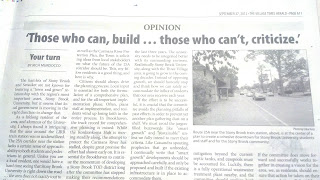The following was published by Times Beacon Record Media on September 26th, 2012.
You can read the online piece here.
The hamlets of Stony Brook and Setauket are not known for fostering a “town and gown” relationship with the region’s most important asset, Stony Brook University, but it seems that local government is moving in the right direction to change that.
As a lifelong resident of the area, and alumnus of the University, I always found it intriguing that the area around the LIRR train station was so underutilized. The 25A corridor near the station lacks a certain sense of approachability to both students and pedestrians in general. Unless you are a local resident, one would have a hard time seeing that Stony Brook University is right down the road … the area does not exactly tout to the rest of the region that there is a world-class research facility just south of 25A.
It seems that the Town of Brookhaven has finally realized what a diamond in the rough the area is, and created the Stony Brook Safety, Beautification and Improvement Planning Committee to plan for the future of the area around the train station, and along the 25A corridor. The creation of a Stony Brook Transit-Orientated Development (TOD) is being proposed, complete with increasing pedestrian access and the encouragement of mixed uses. Using an approach similar to that of the Ronkonkoma Hub, as well as the Carmans River Protection Plan, the Town is soliciting ideas from local stakeholders on what the future of the 25A corridor should be. This, my fellow residents is a good thing, and here is why.
Citizens should always drive the planning process. Local input is essential for both the formulation of a comprehensive plan, and for the all-important implementation phase. Often, plans stall at implementation, and residents wind up losing faith in the entire process. In Brookhaven, the track record for comprehensive planning is mixed: While the Ronkonkoma Hub is moving steadily along, the attempt to protect the Carmans River has stalled, despite great promise the effort had shown early on. It is essential for Brookhaven to continue the momentum of developing a Stony Brook TOD district long after the committee has stopped making their recommendations and formulated a plan, and for policymakers to have the political will to see things through past the election cycle.
Residents must be mindful to play their part as well. It is easy to stomp up and down stating what doesn’t work, gripe about taxes and traffic and be close-minded to new ideas. We must move past this mindset and remember that now is the time in the process where we, as citizens, get to sit down at the table with policymakers and figure out what can work for our area.
Tragically, poor land-use planning has taken the lives of two Stony Brook students within the last three years. The university needs to be integrated better with its surrounding environs. Realistically Stony Brook University, along with the Three Village area, is going to grow in the coming decades. Instead of opposing growth, we should honestly stop and think how we can safely accommodate the influx of students that our area receives each year.
If the effort is to be successful, it is crucial that the committee avoids the planning pitfalls of past efforts in order to prevent yet another plan gathering dust on a shelf. We must avoid the jargon-filled buzzwords like “smart growth” and “sustainable” unless we fully intend to meet their criteria. Like Cassandra spouting prophecies that go unheeded, I continually write that “smart growth” developments should be approached carefully, and only be proposed and built if the existing infrastructure is in place to accommodate them.
“Smart growth” isn’t so clever if the roads cannot handle the extra demand and pedestrians cannot safely get to the new mixed-use sites. The whole corridor should be unified via a streetscape complete with sidewalks, crosswalks, landscaping and LED lighting. Bicycles, pedestrians and automobiles must be given separate spaces that allow for maximum mobility and safety.
We need to remember that on Long Island, project density should always be defined by the capacity of our aquifer system. Given the current state of our groundwater and bays, any new projects must have wastewater mitigation beyond the current septic tanks, and cesspools must be accounted for. Luckily, there is a fully operational wastewater treatment plant nearby, and the committee should explore both expanding and taking advantage of its accessibility. This is an expensive policy recommendation, but it is the only appropriate way to allow for the creation of a fully realized TOD district.
As a young Long Islander, it is frustrating to see people complain about the lack of affordable housing, the brain drain and lack of innovation in the region, yet when the opportunity comes to do something about addressing these issues, nothing gets done. The future development of the Stony Brook TOD is too important to be left to the negative whims of local politics, election-year promises and NIMBYism. If the committee does move forward and successfully works together in creating a vision for the area, we, as residents, should ensure that action be taken on their recommendations. Robert Moses once famously said, “Those who can, build … those who can’t, criticize.” Using the community-based planning process, together we can set a regional precedent that shows that Long Islanders can still get what needs to get done accomplished.
The author has his bachelor’s degrees in political science and urban studies from Fordham University and his master’s in public policy from Stony Brook University. He works for an environmental nonprofit on the East End. You can follow Murdocco on Twitter @TheFoggiestIdea. He lives in Setauket.











